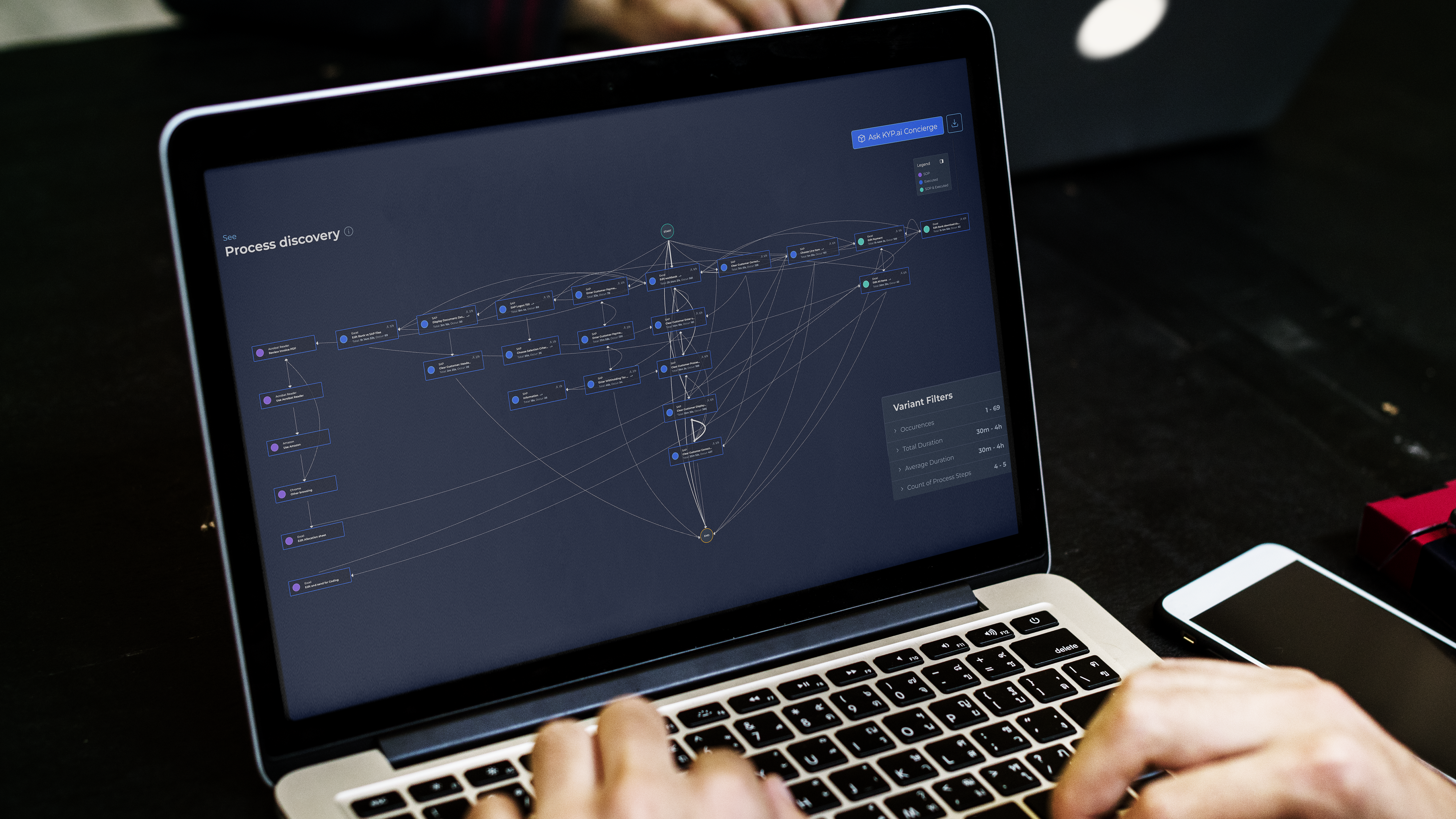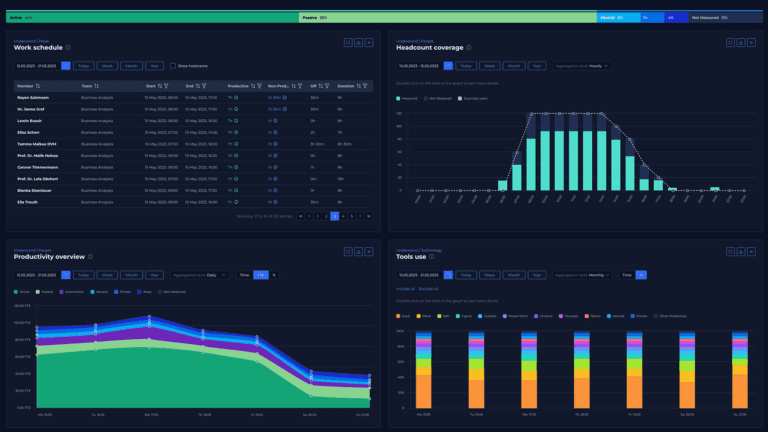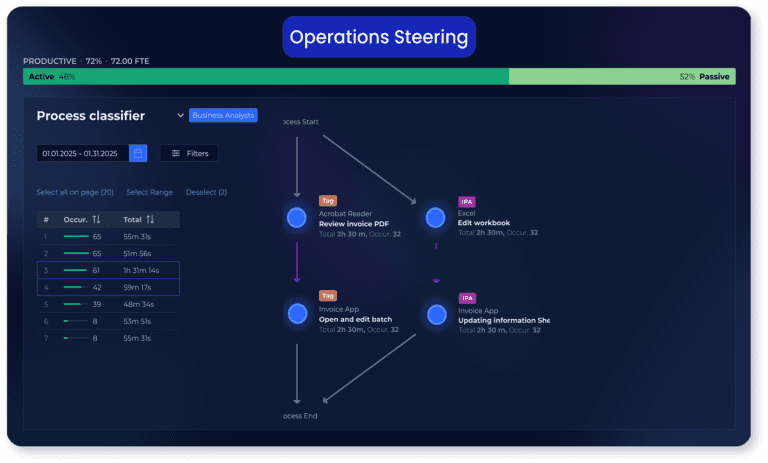| Summary: Data process automation eliminates manual inefficiencies, integrates systems, and delivers real-time actionable insights. As enterprises scale, tools like KYP.ai connect automation with productivity, creating intelligent operations that adapt quickly. By aligning people, processes, and data, automation becomes a support function and a strategic engine for growth, clarity, and smarter decisions. |
Why Data Automation Matters Now More Than Ever
Enterprises today are at a data peak yet struggle with the same old inefficiencies, manual processes, disconnected systems, and reactive decision-making. As volumes grow and customer expectations rise, the traditional ways of moving, managing, and acting on data simply can’t keep up.
Manual data handling is no longer just inefficient; it’s unsustainable. That’s where data process automation (DPA) comes in. It replaces repetitive tasks with intelligent flows, connects silos into unified pipelines, and powers real-time insights that teams can act on. As organizations pursue scale, speed, and sharper decision-making, DPA has become the core infrastructure for operational maturity.
And with the arrival of agentic AI, autonomous agents that can make decisions and execute tasks on behalf of humans, data automation has graduated from a nice-to-have to a foundational capability. Tools like KYP.ai go even further, bringing together intelligent process discovery, automation opportunities, and performance visibility in one platform. The result? A smarter, more agile business ready for whatever comes next.
What is Data Process Automation?
Data process automation uses software to streamline how data moves across systems, how it’s processed, and how it fuels action. At its core, it’s about three things:
- Eliminating repetitive tasks
- Unifying disparate data sources
- Delivering insights quickly and accurately
However, in modern organizations, DPA is more than writing scripts or running scheduled tasks. True DPA involves intelligent logic, contextual understanding, and real-time responsiveness. It doesn’t automate workflows; it enhances them with visibility and precision.
KYP.ai takes this further by tying every automation opportunity back to productivity intelligence. It doesn’t execute tasks, it shows you what’s worth automating and why. You get not just faster data flow, but wiser, outcome-driven decisions.
Core Elements of Data Process Automation
DPA isn’t a one-size-fits-all solution. It’s a framework built on interconnected components that work together to deliver value. Let’s explore these elements.
1. Data Validation
Data is only as valuable as it is trustworthy. DPA starts with validation, ensuring accuracy, completeness, and consistency. With automated checks and real-time anomaly detection, businesses can identify data errors before they cascade into downstream issues.
KYP.ai integrates smart alerts and auto-validation rules, ensuring decisions are always based on clean, reliable inputs.
2. Data Integration
Organizations juggle CRM data, ERP transactions, BPM logs, and spreadsheets from multiple teams. Bringing it all together, without manual effort, is non-negotiable.
Our pre-built connectors and dynamic integration framework allow data to flow seamlessly from modern platforms and legacy systems, creating a single source of operational truth.
3. Workflow Automation
Think beyond task automation. Workflow automation automatically maps entire decision trees, triggering steps, approvals, and follow-ups based on defined logic.
Workflow patterns are identified through real-time user behavior. It pinpoints where logic can be applied, where bottlenecks exist, and which paths lead to the best outcomes.
4. Analytics & Reporting
Every automation story needs an outcome. DPA tools should do more than move data, they should tell you what that data means.
We enrich traditional BI with pre-analyzed, real-time insights, tailored to your KPIs. No more digging through dashboards, clear signals about what’s working and where to focus.
5. Security and Compliance
With automation, governance can’t be an afterthought. DPA platforms must protect data, respect user roles, and log activity for full auditability.
It is built with enterprise-grade encryption, role-based access, and GDPR-aligned data governance, so your automation efforts don’t introduce new risks.
6. ETL (Extract, Transform, Load) Automation
ETL remains the heartbeat of data operations. Automating these steps means fresher data, faster decisions, and fewer errors.
Our process intelligence surfaces where ETL pipelines slow down, identifies transformation bottlenecks, and flags inconsistencies, optimizing the entire data journey from end to end.
Types of Data Automation

Data automation isn’t one-size-fits-all. Let’s look at the core types:
- Integration Automation: Seamless movement of data between apps and systems. KYP.ai connects it all, from APIs to old-school databases.
- Transformation Automation: Cleansing, reshaping, and standardizing data for immediate use.
- Loading Automation: Inserting data into warehouses or reporting tools without human handoffs.
- Real-Time Streaming: Live data pipelines that respond instantly to new information, ideal for dashboards and alerts.
- Triggered/Scheduled Runs: Set processes to run on a schedule or in response to events, such as form submissions or order completions.
- Visualization & Analysis Automation: Auto-generated reports, anomaly alerts, and performance summaries without BI teams having to chase them.
Process Data Automation – The KYP.ai Difference
We stand out in process data automation, capturing how work happens across systems like ERP, CRM, or office tools. It transforms how teams operate by:
- Automatically mapping user journeys and workflows across digital environments.
- Identifying repetitive, high-effort tasks for targeted automation
- Surfacing data-backed recommendations for RPA, AI agents, or low-code tools
- Documenting process paths in real-time, creating up-to-date digital SOPs
- Analyzing workload distribution to highlight team capacity gaps or overload risks
- Supporting objective planning for hiring, outsourcing, or realignment
We eliminate guesswork, allowing operations leaders to act based on evidence, not assumptions.
Key Benefits of Data Automation
A well-implemented data automation strategy doesn’t reduce effort. It transforms how work gets done. Core benefits include:
- Higher Data Quality: Automated validation ensures clean, reliable data upstream
- Significant Time & Cost Savings: Manual, repeatable tasks are eliminated or accelerated
- Improved Productivity: Employees can focus on higher-value work, not data handling
- Real-Time Decision-Making: Instant access to accurate data enables faster, more confident choices
- Scalability & Readiness: Automation systems adapt as your business grows or changes
These benefits are tied directly to measurable outcomes, like hours saved, process improvements, or resource reallocation. It’s automation with accountability.
Common Challenges in Data Automation
Like any meaningful change, automation comes with its hurdles. These include:
- Legacy System Integration: Many older platforms weren’t built to share data easily. Without APIs or standard protocols, connecting them can slow down or complicate automation efforts.
- Initial Setup Costs: Automation is an investment. The upfront costs, in tools, training, and system alignment, can feel steep without clear projections on time-to-value.
- Change Resistance: Even the most efficient system won’t succeed without buy-in. Employees may resist automation because it threatens their roles or disrupts their routines.
- Data Quality at Scale: Poor data hygiene becomes amplified when automated. Smaller errors can become larger issues as systems scale if not proactively addressed.
- Security Risks: Increased connectivity introduces new vulnerabilities. Without strong access controls, audit logs, and encryption, automation can open doors to data breaches or compliance gaps.
We address these through:
- Plug-and-play integrations
- Fast time-to-value use cases
- Process transparency to drive change acceptance
- Granular controls and compliance-grade governance
It’s not just about building automation. It’s about building trust in automation.
Effective Strategies for Implementing Data Automation
To make data automation successful, organizations need more than tools. They need a plan:
- Identify High-Impact Tasks: Focus on high-frequency, high-effort activities
- Start with Visibility: Use process intelligence to understand how work happens today
- Pick the Right Tools: Solutions like KYP.ai offer targeted automation aligned with productivity gains
- Train and Empower Teams: Show employees how automation supports them, not replaces them
- Iterate and Improve: Monitor results, adapt logic, and refine workflows continuously
The best automation journeys are guided by data, grounded in process reality, and driven by outcomes.
Real-World Use Cases and Examples
1. Capacity & Effort Modeling
We help businesses understand who’s doing what, and how much effort is required. This supports hiring decisions, outsourcing strategies, and automation investment cases backed by real usage data.
2. Triggered Ingestions
Instead of static reports, data updates are dynamically based on system activity, such as when a sale is closed, a support ticket escalates, or inventory dips. KYP.ai captures these moments and feeds insights immediately.
3. Streaming Analytics
KYP.ai provides live dashboards that surface real-time performance data, from operational KPIs to employee workloads. This keeps leaders connected to the pulse of their business without needing to chase reports.
Each use case highlights a central theme: visibility and action, without delay or guesswork.
What to Look for in a Data Automation Platform
Choosing the right platform makes all the difference. Prioritize solutions that offer:
- Scalability: Can it grow with your business?
- Observability: Can you see what’s happening at every step?
- System Compatibility: Does it integrate with what you already use?
- No-Code/Low-Code Options: Can business users engage without IT bottlenecks?
- Real-Time Intelligence: Are insights immediate and contextual?
- Governance: Are security and compliance built-in, not bolted on?
KYP.ai checks each box, making it a future-proof choice for data-driven operations.
Future Trends in Data Automation
The landscape is shifting fast. Here’s what’s next:
- AI/ML-Driven Logic: Automation evolves beyond static rules, learning from patterns and improving continuously with AI.
- Hyperautomation: Integrates task, process, and strategy-level automation into a single, scalable framework for transformation.
- Edge Responsiveness: Data is processed near its source, enabling faster, real-time decisions without relying solely on the cloud.
- Conversational Interfaces: Users interact with systems using plain language, making data access as intuitive as asking a question.
- Agentic AI: Autonomous AI agents take initiative, executing complex tasks across systems with minimal human input.
KYP.ai is already aligning to these trends, focusing on real-time intelligence, predictive logic, and adaptive automation paths that mirror real business needs.
Conclusion: Building an Intelligent Data-Driven Future
Data processing automation is not an IT project. It’s a business imperative. When data flows freely, accurately, and intelligently, organizations become more agile, focused, and competitive.
But the real advantage isn’t just in cost savings. It’s in unlocking strategic clarity, operational resilience, and people-powered productivity.
With platforms like KYP.ai, you’re not just automating. You’re elevating how your business sees, understands, and improves itself.
The roadmap is clear if you can turn manual effort into measurable impact. KYP.ai is ready to help.
Frequently Asked Questions:
Q: Which of your current data processes consumes the most time and could benefit from automation?
A: Typically, repetitive data entry, report consolidation, and manual handoffs between systems eat up the most time, making them prime candidates for automation.
Q: How effectively are your teams leveraging data insights in real-time decision-making today?
A: Real-time action suffers if insights are delayed or buried in dashboards. Tools like KYP.ai help surface what matters and when it matters.
Q: What challenges have you faced when integrating data across systems or departments?
A: Siloed platforms, legacy tools, and inconsistent formats often slow or block integration. KYP.ai connects these seamlessly for unified insights.
Q: Is your organization ready for hyperautomation, or are you still navigating basic data workflows?
A: Many teams are mid-journey, automating basics but lacking connected intelligence. KYP.ai bridges that gap and scales with you.
Q: How would having end-to-end visibility into your data and process performance, like what KYP.ai offers, change your operations?
A: It would eliminate guesswork, spotlight inefficiencies, and empower teams to take action with clarity, fueling faster, more confident decisions.
Discover Your Productivity Potential – Book a Demo Today
Book Demo








